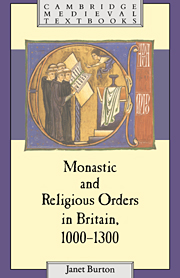Book contents
- Frontmatter
- Contents
- List of illustrations
- Preface
- 1 Before the Normans
- 2 The coming of the Normans
- 3 The regular canons
- 4 The new monastic orders of the twelfth century
- 5 Women and the religious life
- 6 The mendicant orders
- 7 The physical setting: monastic buildings and the monastic plan
- 8 Inside a religious house: daily life and the chain of command
- 9 Learning and literary activities
- 10 Religious houses and the wider community: founders, patrons and benefactors
- 11 The monastic economy
- 12 On the brink of change
- Glossary
- Notes
- Select bibliography
- Index
- Cambridge Medieval Textbooks
11 - The monastic economy
Published online by Cambridge University Press: 05 June 2012
- Frontmatter
- Contents
- List of illustrations
- Preface
- 1 Before the Normans
- 2 The coming of the Normans
- 3 The regular canons
- 4 The new monastic orders of the twelfth century
- 5 Women and the religious life
- 6 The mendicant orders
- 7 The physical setting: monastic buildings and the monastic plan
- 8 Inside a religious house: daily life and the chain of command
- 9 Learning and literary activities
- 10 Religious houses and the wider community: founders, patrons and benefactors
- 11 The monastic economy
- 12 On the brink of change
- Glossary
- Notes
- Select bibliography
- Index
- Cambridge Medieval Textbooks
Summary
On numerous occasions the Rule of St Benedict reminds the monks that they are to have no private possessions. But it was assumed that the monastery would have possessions; and this was in no way incompatible with the monastic ideal. Poverty was personal, not corporate. Religious houses became landowners; and their economic practices were affected by a number of factors. First, there was the ethos of the order to which a house belonged. The Cistercians, as we have seen, sought remote sites and rejected all revenue which was derived either from the possession of spiritualia or from the work of others. The mendicants were not intended to own property at all, although certain friaries did come into possession of arable land, orchards and gardens in their immediate vicinity. Equally important factors in the economic development of a house were its size and geographical location and the nature and extent of its estates, and their distance from the mother house. These conditions in turn bear upon the records which were generated, and determine what we can know of the management of monastic estates. On the whole, large houses with sizeable holdings produced more records, and are accordingly much better documented than smaller ones. Thus, the following discussion, which looks more closely at two major aspects of the monastic economy, sources of income and the management of resources, centres on the large houses, which cannot but distort the overall picture.
- Type
- Chapter
- Information
- Monastic and Religious Orders in Britain, 1000–1300 , pp. 233 - 263Publisher: Cambridge University PressPrint publication year: 1994

